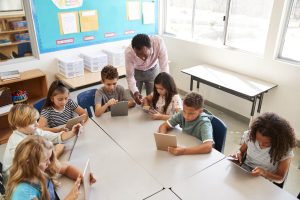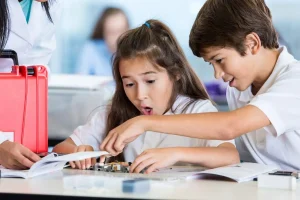In an increasingly complex world, the traditional methods of teaching are often inadequate to engage today’s diverse student population. As educators strive to prepare students for the challenges of the future, innovative teaching methods are becoming essential. These approaches not only enhance engagement but also foster critical thinking, creativity, and collaboration among students. This article explores several innovative teaching methods that can effectively engage students in the classroom.
 1. Project-Based Learning (PBL)
1. Project-Based Learning (PBL)
Project-Based Learning (PBL) is an instructional method that encourages students to learn by actively engaging in real-world and personally meaningful projects. In PBL, students work on projects over an extended period, which allows them to investigate and respond to complex questions, problems, or challenges.
Benefits of PBL
- Deep Learning: Students gain a deeper understanding of the subject matter as they apply knowledge to practical situations.
- Collaboration: PBL fosters teamwork as students often work in groups, enhancing their collaborative skills.
- Critical Thinking: By tackling real-world problems, students develop critical thinking and problem-solving skills.
Examples of PBL
- Community Projects: Students can work on projects that address local community issues, such as environmental sustainability or social justice.
- Interdisciplinary Projects: Combining subjects like science and art, students might create a project that involves designing an ecological garden.
2. Flipped Classroom
The flipped classroom model reverses traditional teaching methods. In this approach, students learn new content at home through videos and online resources, while class time is devoted to engaging in hands-on activities, discussions, and collaborative work.
Benefits of Flipped Classroom
- Increased Engagement: Students come to class prepared, allowing for more interactive and engaging discussions.
- Personalized Learning: Students can learn at their own pace, reviewing content as needed before applying it in class.
- Active Learning Environment: Class time focuses on applying knowledge, which helps reinforce learning.
Implementation Tips
- Video Lectures: Create short video lectures to explain concepts, ensuring they are concise and engaging.
- Interactive Activities: Use class time for group discussions, problem-solving activities, or labs that reinforce the material learned at home.
3. Gamification
Gamification incorporates game elements into the learning process to boost student motivation and engagement. By turning lessons into games or incorporating competitive elements, educators can create a more dynamic classroom environment.
Benefits of Gamification
- Motivation: Game mechanics, such as points, badges, and leaderboards, can motivate students to participate actively in their learning.
- Instant Feedback: Games often provide immediate feedback, allowing students to understand their progress and areas for improvement.
- Fun Learning Environment: Gamification makes learning fun, which can enhance student retention of information.
Examples of Gamification
- Classroom Quizzes: Use platforms like Kahoot! or Quizizz to create interactive quizzes that encourage friendly competition.
- Learning Badges: Implement a badge system to reward students for completing tasks, mastering skills, or achieving goals.
4. Collaborative Learning
Collaborative learning emphasizes teamwork and peer interaction as key components of the educational process. Students work in small groups to complete tasks, solve problems, or engage in discussions, fostering a sense of community and shared responsibility for learning.
Benefits of Collaborative Learning
- Enhanced Communication Skills: Students develop essential interpersonal skills by collaborating with peers.
- Diverse Perspectives: Working in groups exposes students to different viewpoints, enriching the learning experience.
- Peer Learning: Students can learn from one another, reinforcing their understanding of the material.
Implementation Strategies
- Group Projects: Assign collaborative projects that require teamwork and communication.
- Peer Teaching: Encourage students to teach each other certain concepts, reinforcing their understanding while helping classmates.
5. Inquiry-Based Learning
Inquiry-Based Learning (IBL) encourages students to ask questions, conduct research, and explore topics deeply, fostering a sense of curiosity and ownership of their learning. In IBL, the teacher acts as a facilitator rather than a direct instructor.
Benefits of Inquiry-Based Learning
- Critical Thinking: Students learn to think critically as they formulate questions and seek answers.
- Engagement: The process of inquiry engages students in active learning, making them more invested in the subject matter.
- Skill Development: IBL develops research, analytical, and presentation skills as students explore and communicate their findings.
Examples of IBL
- Research Projects: Assign students a topic to investigate and present their findings to the class.
- Problem Solving: Present real-world problems and encourage students to devise solutions based on their research and analysis.
6. Technology Integration
Integrating technology into the classroom can significantly enhance student engagement. From interactive whiteboards to educational apps and virtual reality, technology offers countless opportunities to make learning more interactive and immersive.
Benefits of Technology Integration
- Interactive Learning: Technology can turn traditional lessons into interactive experiences that captivate students’ attention.
- Access to Resources: Students can access a wealth of information and educational tools online, broadening their learning opportunities.
- Skill Development: Familiarity with technology prepares students for a digitally-driven workforce.
Implementation Ideas
- Virtual Field Trips: Use virtual reality to take students on field trips to historical sites or natural wonders without leaving the classroom.
- Educational Apps: Incorporate apps that reinforce learning through games, quizzes, and interactive content.
7. Differentiated Instruction
Differentiated instruction involves tailoring teaching methods and resources to accommodate the diverse learning styles and abilities of students. By providing various ways to engage with material, educators can meet individual needs and promote success.
Benefits of Differentiated Instruction
- Personalized Learning: Students receive instruction suited to their learning preferences and abilities, enhancing their experience.
- Increased Engagement: Offering choices in how to learn and demonstrate understanding keeps students engaged and motivated.
- Support for All Learners: Differentiation supports students with varying backgrounds and abilities, ensuring everyone has the opportunity to succeed.
Implementation Strategies
- Flexible Grouping: Organize students into different groups based on their needs for specific projects or lessons.
- Choice Boards: Create choice boards that allow students to select how they want to learn a concept, whether through reading, videos, hands-on activities, or presentations.
 Conclusion
Conclusion
Innovative teaching methods are essential for engaging students in today’s diverse and fast-paced learning environment. By incorporating strategies such as project-based learning, flipped classrooms, gamification, collaborative learning, inquiry-based learning, technology integration, and differentiated instruction, educators can create dynamic and inclusive classrooms that foster a love for learning.
As we move forward in education, embracing these innovative approaches will be crucial in preparing students for the challenges and opportunities of the future. By prioritizing engagement and active participation, teachers can inspire lifelong learners who are equipped to thrive in an ever-changing world.


